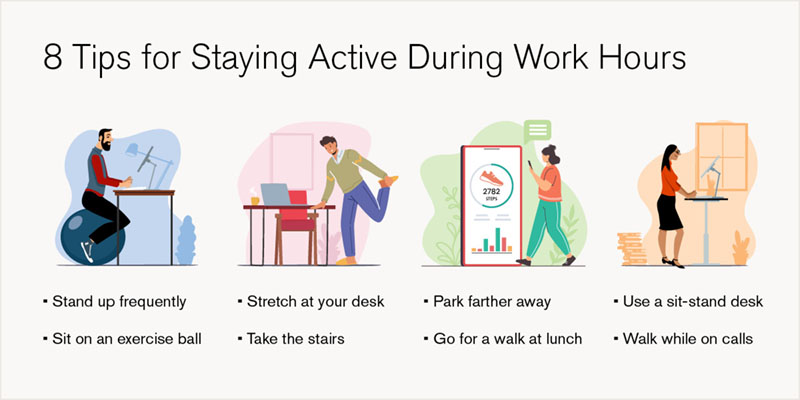How Exercise Improves Mental Health and Reduces Workplace Stress
Regular physical activity has been proven to improve mental health, reduce stress, and create a healthier, more balanced work environment.
Regular physical activity has been proven to improve mental health, reduce stress, and create a healthier, more balanced work environment.

Workplace stress has become a significant concern in modern times, with employees across industries facing mounting pressure to meet deadlines, achieve targets, and maintain productivity.
As this stress takes a toll on mental health, employers and employees alike are exploring ways to combat its effects.
Among the most effective and natural remedies is exercise.
Regular physical activity has been proven to improve mental health, reduce stress, and create a healthier, more balanced work environment.

The relationship between exercise and mental well-being is well-documented.
Engaging in physical activity triggers the release of endorphins—commonly known as "feel-good" hormones—which help alleviate feelings of stress and anxiety.
Additionally, exercise reduces the levels of cortisol, the body’s primary stress hormone, leading to a more relaxed and calm state of mind.
For professionals juggling demanding schedules, incorporating physical activity into their routine can significantly enhance their ability to cope with stress.
Whether it’s a quick gym session, a brisk walk, or a yoga class, exercise helps clear the mind and restore focus.

Workplace stress often stems from long hours, sedentary work environments, and constant connectivity through emails and messaging apps.
Exercise provides a much-needed break from these pressures, offering both physical and psychological benefits.
Improved Focus and Productivity: Regular physical activity boosts cognitive function, enhancing problem-solving skills and creativity. Employees who exercise are better equipped to tackle complex tasks with clarity and efficiency.
Reduced Absenteeism: Physical and mental health are closely intertwined. Employees who engage in regular exercise are less likely to experience burnout, fatigue, or illness, resulting in fewer sick days.
Stronger Resilience: Exercise strengthens not just the body but also the mind, helping individuals build resilience to handle workplace challenges more effectively.

Group Exercise Activities, such as fitness classes or team sports, foster camaraderie among employees.
These shared experiences help build stronger interpersonal relationships, reducing feelings of isolation that often contribute to workplace stress.
Encouraging employees to take advantage of employee gym membership discounts, like those provided by Pluxee UK can promote participation in group fitness programs, creating a sense of community within the workplace.
This, in turn, enhances team dynamics and morale, contributing to a positive organisational culture.

In addition to alleviating stress, exercise can also serve as a preventative measure against mental health issues such as anxiety and depression.
By maintaining a regular exercise routine, employees can better manage their emotional well-being and avoid the long-term effects of chronic stress.
This proactive approach benefits not only the individual but also the organization.
Employees with good mental health are more likely to be engaged, motivated, and committed to their work.

While the benefits of exercise are clear, finding the time to stay active can be challenging, especially for busy professionals.
However, small changes can make a big difference. Here are some practical ways to incorporate physical activity into the daily routine:
Lunch Break Workouts: Use lunch breaks to visit a nearby gym or go for a brisk walk. Even a 30-minute session can have a positive impact on mental health.
Active Commuting: Cycling or walking to work can double as exercise while reducing commuting stress.
Stretch Breaks: Encourage employees to take short breaks throughout the day to stretch or do light exercises at their desks.
On-Site Fitness Facilities: Providing access to on-site gyms or partnerships with fitness centres can make exercise more accessible.
Employers play a vital role in supporting their staff’s mental and physical well-being.
Offering perks such as employee gym membership discounts not only encourages healthy habits but also demonstrates a commitment to employee wellness.
These initiatives can lead to higher job satisfaction, reduced turnover, and a more engaged workforce.
By making fitness opportunities affordable and convenient, employers can empower their teams to take control of their health and combat workplace stress more effectively.

Beyond immediate stress relief, exercise offers numerous long-term benefits for mental health and workplace dynamics:
Enhanced Mood: Regular physical activity is associated with improved mood and reduced symptoms of depression and anxiety. Happier employees contribute to a more positive work environment.
Better Sleep Quality: Exercise promotes better sleep patterns, which are crucial for managing stress and maintaining focus during the workday.
Improved Energy Levels: Physical activity boosts energy, enabling employees to approach their tasks with enthusiasm and drive.
Reduced Healthcare Costs: Healthier employees mean fewer medical expenses for both individuals and organisations.
To truly harness the benefits of exercise, organizations need to foster a culture of wellness.
This involves creating an environment where employees feel encouraged to prioritize their health without fear of judgement or repercussions.
Initiatives such as wellness challenges, fitness reimbursements, and access to mental health resources can reinforce the importance of physical activity.
When organisations actively promote these values, employees are more likely to adopt healthier lifestyles and maintain better mental health.
Exercise is more than just a physical activity—it’s a powerful tool for improving mental health and reducing workplace stress.
By integrating fitness into daily routines and taking advantage of opportunities like Pluxee UK’s employee gym membership discounts, individuals can enhance their resilience, focus, and overall well-being.
For organisations, supporting employee fitness initiatives is a strategic investment in productivity and morale.
As stress levels continue to rise in today’s fast-paced work environments, prioritizing mental and physical health through exercise is a step in the right direction—for employees and employers alike.
Your cart is currently empty.
Start Shopping